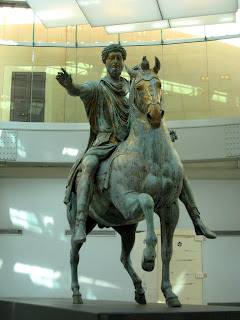Bob slept in today, so Gary, Karin and I (Steward) were on our own without our map reader. Somehow we managed to find our way to our destinations and even return safely home in the afternoon.

Our first stop was the Palazzimo alle Terme, a relative new and modern museum with splendid lighting and explanations in English as well as Italian. It traces Roman history for about six centuries through statues, mosiacs, frescoes, and even entire rooms preserved from villas dating back to the time of Augustus (just before and after 1 AD).

One thing I'd never seen before was mosaics made not of tiny colored stones, but of pieces of colored marble and semi-precious stones. Here are a couple of examples, one of them about some lovely ladies raping a clearly distressed young man.
 We then had enough energy to stop by Palazzo Barbarini to see, among other things, two more Caravaggios: "Narcissus" and "Judith Beheading Holofernes." Although Judith, by seducing Holofernes, getting him drunk, cutting off his head, and thereby saving her people from slaughter, looks conflicted. "How can I do such a terrible thing? How can I NOT do such a terrible thing?" The old hag standing behind her with a bag to carry off the head clearly had no such qualms.
We then had enough energy to stop by Palazzo Barbarini to see, among other things, two more Caravaggios: "Narcissus" and "Judith Beheading Holofernes." Although Judith, by seducing Holofernes, getting him drunk, cutting off his head, and thereby saving her people from slaughter, looks conflicted. "How can I do such a terrible thing? How can I NOT do such a terrible thing?" The old hag standing behind her with a bag to carry off the head clearly had no such qualms.

Our first stop was the Palazzimo alle Terme, a relative new and modern museum with splendid lighting and explanations in English as well as Italian. It traces Roman history for about six centuries through statues, mosiacs, frescoes, and even entire rooms preserved from villas dating back to the time of Augustus (just before and after 1 AD).

One thing I'd never seen before was mosaics made not of tiny colored stones, but of pieces of colored marble and semi-precious stones. Here are a couple of examples, one of them about some lovely ladies raping a clearly distressed young man.
 We then had enough energy to stop by Palazzo Barbarini to see, among other things, two more Caravaggios: "Narcissus" and "Judith Beheading Holofernes." Although Judith, by seducing Holofernes, getting him drunk, cutting off his head, and thereby saving her people from slaughter, looks conflicted. "How can I do such a terrible thing? How can I NOT do such a terrible thing?" The old hag standing behind her with a bag to carry off the head clearly had no such qualms.
We then had enough energy to stop by Palazzo Barbarini to see, among other things, two more Caravaggios: "Narcissus" and "Judith Beheading Holofernes." Although Judith, by seducing Holofernes, getting him drunk, cutting off his head, and thereby saving her people from slaughter, looks conflicted. "How can I do such a terrible thing? How can I NOT do such a terrible thing?" The old hag standing behind her with a bag to carry off the head clearly had no such qualms.





















